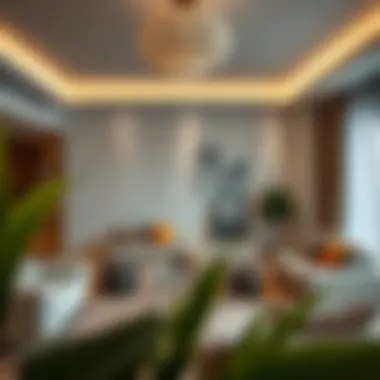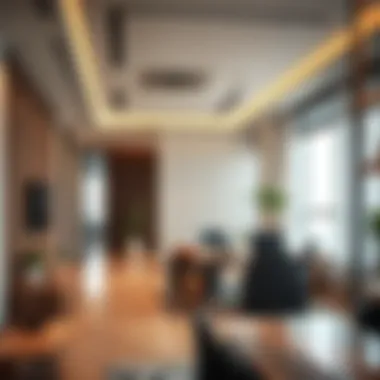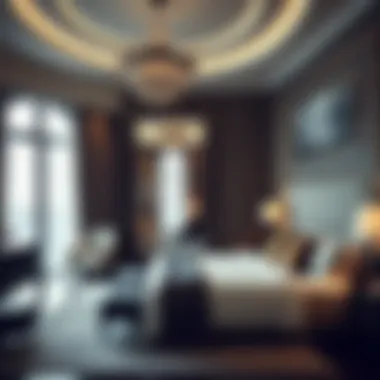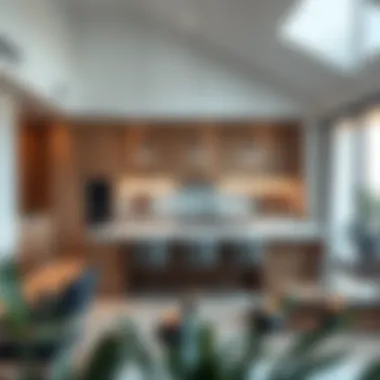Interior Decoration Companies in Dubai: Key Insights


Intro
This guide dives into the world of interior decoration companies, specifically focusing on Dubai’s unique property landscape. For those looking to invest, whether homeowners or expatriates, understanding nuances of this industry is crucial. Not only can the right decoration transform spaces, giving them a new lease on life, but it can also significantly influence property values and tenant experiences. This article will walk you through market trends, provide investment strategies, and emphasize how crucial maintaining effective communication with design professionals is. Thus, let's embark on this journey to unlock the potential of interior decoration.
Market Trends
Current Property Prices
Dubai's real estate market has seen notable fluctuations over the years. As of late 2023, various sources indicate that average property prices are stabilizing after a prior boom cycle, largely influenced by urban development and continued demand from both local and expatriate buyers. Luxury apartments, for instance, can range anywhere from AED 1 million to multiples of that, depending on the area.
The rise in property values in neighborhoods like Downtown Dubai or Dubai Marina has put a spotlight on well-decorated spaces. Interiors that resonate with a blend of modern aesthetics and cultural elements often see quicker sales and higher lease values.
Future Market Predictions
Looking ahead, experts foresee continued growth in the interior decoration sector driven by technology and sustainability trends. They predict a paradigm shift towards eco-friendly materials and smart-home designs. Navigating market shifts will be key; savvy investors will want to keep an eye on these trends to capitalize on upcoming business opportunities.
"Investing in properties that incorporate modern interior designs not only enhances visual appeal, but it can significantly increase valuation in a snapping market."
With urban expansion ongoing, neighborhoods that previously might have seemed remote are also in line for booming demand. Here in the Gulf region, one would be wise to monitor emerging hotspots to ensure strategic investments.
Investment Strategies
Smart Buying Tips
When looking to engage an interior decoration company, timing and selection can be pivotal. Here are some practical tips:
- Research Local Companies: Delve into the portfolios of various firms. Look for client reviews and completed projects to gauge their competency.
- Prioritize Experience: Established companies bring a wealth of knowledge which can prove invaluable; focus on those who have weathered previous market downturns.
- Set a Budget: Distinguish between wants and needs. Interior decoration can be expensive, so make sure to set a realistic budget that encompasses not only design, but also materials and potential renovations.
Financing Options
Investing in interior decoration doesn’t have to break the bank. Consider exploring different financing options:
- Home Equity Loans: If you've accumulated sufficient equity in your property, this can provide a means to fund decorative upgrades with lower interest rates.
- Personal Loans: These can be a feasible alternative, especially if your financial circumstances enable manageable repayments.
- In-House Financing: Some interior decoration companies offer their financing solutions, which can ease the burden while allowing for dream designs.
By weaving thoughtful designs with shrewd investment strategies, individuals can maximize both their living experience and long-term property values. Always bear in mind to communicate clearly with your interior decoration company and outline your expectations to ensure a smooth process.
Understanding the Role of an Interior Decoration Company
Engaging an interior decoration company represents a significant commitment for homeowners and businesses alike. These professionals wield the power to transform spaces into reflections of personal taste or corporate identity. In a bustling metropolis like Dubai, where aesthetic value can directly affect property marketability, understanding the role of these companies is crucial.
Interior decoration goes beyond mere aesthetics. These companies offer an array of services, ranging from selecting color palettes to sourcing furniture. Each aspect of their work serves a purpose in elevating not just the appearance but also the functionality of a space. As you're navigating through Dubai's competitive real estate scene, making informed decisions about interior decoration can increase your property's value and appeal.
Defining Interior Decoration
At its core, interior decoration involves enhancing a space by strategically selecting and arranging various elements. This includes furniture, color schemes, lighting, and decorative accessories. Unlike renovation or structural design, which may require construction, interior decoration focuses on the art of manipulating visual aspects without altering the physical architecture.
To illustrate, consider a typical living room. An interior decorator might choose a palette of soft blues and creams to create a serene atmosphere while incorporating textures through plush cushions and curtains. By organizing furniture in a way that fosters conversation, the decorator achieves a practical yet appealing layout.
Differences Between Interior Decoration and Interior Design
Though often used interchangeably, the terms 'interior decoration' and 'interior design' represent distinct practices. Interior design encompasses a broader scope, integrating aspects of both aesthetics and functionality. It often involves space planning, building codes, and safety regulations. An interior designer might work on commercial projects, needing to consider efficiency and workflow in their designs.
Conversely, interior decoration prioritizes the visual enhancement of spaces, focusing squarely on aesthetics without delving into structural elements. For example, while a designer might rethink an office layout to improve workflow, a decorator would select furniture and colors to elevate its appeal once the design has been set.
"Understanding these distinctions can save you time and money when deciding which professional you need for your project."
In summary, a reputable interior decoration company isn’t just about making something look good; it’s about making your environment feel right. Whether it’s a cozy family home or a corporate office, the strategic work of these professionals can create spaces that truly resonate with their inhabitants. By appreciating their role, potential clients can engage more thoughtfully with these experts, ensuring a partnership that leads to environments that inspire and function seamlessly.
Choosing the Right Interior Decoration Company
Choosing the right interior decoration company is not just about aesthetics; it's a critical decision that can significantly impact a property’s value and the overall satisfaction of its inhabitants. The essence of effective interior decoration lies in creating spaces that resonate with functionality and style, meeting the unique preferences of the homeowner or tenant. When embarking on a design project, understanding the key factors that play into selecting the right company becomes paramount.
A well-chosen interior decoration company not only brings a fresh perspective but also adds tangible value to properties, which is especially crucial in a competitive market like Dubai. Reasons to invest time in the selection process include securing quality design, optimizing project timelines, and ensuring outstanding post-completion service. If you want to avoid pitfalls often associated with hastily made decisions, taking a moment to evaluate your options is essential.
Assessing Credentials and Experience
When looking into an interior decoration company, credentials and experience serve as foundational elements. This is where you’ll want to dig deeper.
- Check certifications: Many reputable companies often hold certifications from recognized institutions or professional organizations. These credentials can be indicative of their commitment to industry standards.
- Years in business: Longevity in the market can signal expertise. An established company will likely have navigated various market fluctuations, leading to adept problem-solving skills.
- Client testimonials and references: It's always a good idea to reach out to previous clients. Satisfaction levels can often be gauged through real experiences shared by others.
Having a solid foundation in these areas ensures that you engage a professional who is capable of delivering quality work tailored to your needs.


Evaluating Portfolio and Style
The portfolio of an interior decoration company provides a window into their style and capabilities. By reviewing past projects, you can gather insights that help forecast whether their aesthetic aligns with your vision.
- Diversity of work: Look for companies that showcase a range of styles—this indicates versatility and adaptability to various client needs.
- Attention to detail: Evaluate not just the overall design, but also the attention to finer touches. It might be a small detail like the choice of materials or how well the design integrates with existing architecture.
- Client engagement: Some portfolios highlight case studies where clients were heavily involved in the design process, which may appeal to those who wish to collaborate closely with designers.
A thorough examination of their portfolio will help you gauge the potential fit between your vision and their design philosophy.
Understanding Specializations within the Industry
Not all interior decoration companies are created equal, and each may focus on different aspects of design based on their skill set and experience. Understanding these specializations can guide you toward making a more informed choice.
- Residential vs. commercial: Some companies might specialize in residential spaces—homes, apartments—while others excel in designing commercial environments like offices or retail spaces. Knowing what you need will streamline your search.
- Particular styles or themes: Certain firms may have expertise in minimalism, modern chic, or traditional designs and could offer specialized services tailored to your preferences.
- Sustainability practices: If eco-friendliness is critical to you, seek out companies that emphasize sustainable practices in their designs, such as utilizing renewable materials or energy-efficient systems.
By recognizing specialties in the industry, you can align your selection process with your specific project requirements, ensuring a design that not only looks good but truly matches your lifestyle and values.
The Design Process: What to Expect
The design process in interior decoration is more than just picking out pretty fabrics or finding the right paint color. It offers a structured way to create environments that are not just visually appealing but also functionally efficient. This stage of the project is pivotal, as it can set the tone for the entire undertaking. Understanding what to expect can bridge the gap between your vision and the final result, and can significantly impact your investment.
Initial Consultation and Briefing
The first step in the design process, the initial consultation, is like laying the groundwork for a building. It’s where ideas begin to take shape, and clarity starts to emerge. During this meeting, clients discuss their needs, preferences, and budgetary constraints. This isn’t merely a check-list exercise; it’s a conversation that helps the interior decoration company gauge the essence of what the client seeks.
A successful initial consultation will unravel several things:
- Vision Sharing: Clients should articulate their vision clearly. Sharing inspiration—whether through Pinterest boards or magazine clippings—helps the designer to understand the desired outcome.
- Budget Discussion: Transparency regarding financial limits is crucial. This honest dialogue can help avoid surprises down the road, ensuring that both parties are on the same page about what can realistically be achieved.
- Timeline Expectations: Discussing a realistic timeline is beneficial for setting expectations. Knowing how long each phase will take helps in planning, especially for homeowners eager to see changes.
Building rapport during this stage is essential. The effectiveness of communication often predicts project success. As they say, "a stitch in time saves nine." Thus, investing time here can save heaps of trouble later on.
Conceptual Design and Mood Boards
Once the groundwork is laid, the next step dives into conceptual design. This phase is where ideas take visual form. Designers usually create mood boards to encapsulate the larger vision and the aesthetics involved. A mood board is akin to a visual storybook—combining colors, shapes, materials, and furniture pieces to give a cohesive design outlook.
- Visual Representation: Mood boards serve as an important communication tool. They allow clients to see potential transformations, ensuring everyone’s on the same wavelength.
- Exploring Styles: During this stage, style preferences are fine-tuned. Whether leaning towards minimalist, industrial, or vintage, it’s essential for the designer to capture the essence of the desired style accurately.
- Iterative Process: Feedback is king here. Nothing is set in stone, and changes can often be made in response to client wishes, making this part exciting and collaborative.
Having a range of options paves the way for informed decisions, and if clients engage fully during this stage, they’ll likely end up with a design that truly resonates with them.
Implementation and Project Management
The implementation phase is where the rubber meets the road. It requires meticulous attention to detail, as the vision crafted in the previous stages comes to life. It’s not just about throwing together furniture and artwork; it entails a systematic approach.
- Coordinated Efforts: This phase involves various tradespeople—contractors, artisans, and suppliers. A project manager usually oversees these dynamics, ensuring timing, quality, and expectations are kept in check.
- Problem Solving: Unexpected issues can arise—be it delivery delays, structural challenges, or last-minute design changes. This is where adaptability shines. Having someone in charge to swiftly address these matters ensures the project stays on course.
- Final Touches: Once the bulk of the work is completed, attention turns to the finer details. This might involve styling spaces, arranging furniture, or even selecting art pieces to accentuate the design.
In short, implementation is less about being rigid and more about maintaining flexibility while sticking to the original vision. Ultimately, it culminates in a space that reflects the desires and style of the client.
"The goal of the design process is to turn dreams into reality—capturing one’s essence and translating it into physical spaces."
Budgeting for Interior Decoration
Navigating the labyrinth of interior decoration requires more than an eye for design; it demands a keen understanding of budgeting. Allocating funds appropriately can be the linchpin that ensures your project runs smoothly and aligns with your vision. From homeowners to investors, knowing how to balance cost against aspiration will define the success of any renovation or decoration endeavor. A good budget not only supports creative expression but also secures financial peace of mind.
Understanding Costs Involved
When tackling an interior decoration project, the first step is to identify what costs will arise. This involves contemplating every aspect of the job, from basic materials to intricate details. Here are some common costs you might encounter:
- Materials: Depending on the style and quality, materials can span a broad range—from wallpaper and paint to flooring and fixtures.
- Labor: Hiring skilled decorators or contractors can be a hefty but necessary expense. Consider the level of expertise required and the going rate in your area.
- Furniture and Accessories: New furniture can dramatically affect the look of a space but can also eat into your budget quickly.
- Professional Fees: Interior decorators usually charge a fee for their service, either hourly or as a percentage of the total project cost.
Highlighting these components allows for informed planning, preventing budget blowouts that could derail the entire project. It’s like cooking without a recipe—without knowing what’s on the menu, you’re likely to burn the dinner!
Setting a Realistic Budget
Setting a budget is an exercise in balancing dream with reality. To get started, follow these steps:
- Assess Your Financial Situation: Take a good, hard look at your finances. How much can you realistically allocate for this project?
- Prioritize Goals: Identify what aspects of the decoration are non-negotiable versus those that could be scaled back. For example, if you absolutely must have high-end fixtures, perhaps consider less expensive decor items to even it out.
- Research and Quotes: Before making any firm commitments, gather quotes from various suppliers and contractors. It'll give you a concrete idea of current market rates.
A budget should be flexible, allowing some wiggle room for adjustments without feeling like your hands are tied. Things do change and being stuck with a rigid financial plan can lead to a world of heartache.
Managing Unexpected Expenses
No matter how thoroughly one plans, life’s little surprises often rear their unexpected heads. Here’s how to cushion the blow of unexpected expenses:
- Contingency Fund: Setting aside 10-20% of your budget as a contingency fund can be a lifesaver. This reserve allows you to tackle unforeseen costs without doing a complete belt-tightening act.
- Regular Check-Ins: Monthly or bi-weekly meetings with your decorating team can keep the project on track and reveal any potential issues before they snowball.
- Keep an Open Mind: Sometimes, the unexpected can lead to fantastic opportunities. For instance, discovering antique flooring can alter your entire design concept—usually for the better!


"Plans can change, but a well-structured budget keeps you grounded amidst uncertainty."
In the realm of interior decoration, budgeting is not merely a task; it’s a vital skill that intertwines practicality with creativity. Understanding costs, setting a realistic budget, and managing surprises make for a smoother project experience, one that can turn your vision into an eye-catching reality.
Impact of Interior Decoration on Property Value
When thinking about interior decoration, many people often underestimate its importance, especially in the context of property value. With a variety of factors influencing real estate markets, how a space is presented can make a significant difference in appeal and valuation. This section aims to delve deeper into how effective interior decoration strategies can enhance property values, offering insights for both owners and investors alike.
Market Trends and Buyer Preferences
Current market trends reveal a shifting landscape in buyer preferences. Increasingly, prospective buyers are gravitating towards homes that reflect a modern aesthetic while incorporating sustainable practices. A key point to note is that features such as open layouts, ample natural light, and meticulous design choices are now non-negotiable among discerning buyers.
- Smart home features: Many buyers now expect homes infused with technology, from built-in sound systems to intelligent climate controls.
- Sustainability: Eco-conscious buyers are inclined to appreciate properties that use sustainable materials or incorporate energy-efficient designs.
- Personalization: Customized designs appeal greatly, allowing buyers to feel a sense of ownership even before moving in.
These trends show that not only does a well-decorated space boost aesthetic appeal but also aligns with modern consumer desires, thus increasing its market value.
Creating Desirable Spaces for Tenants
For landlords and property managers, creating tenant-friendly spaces is crucial. Interior decoration can influence tenant satisfaction and retention rates, directly impacting income from rental properties. An investment in quality decor can yield high returns.
- Comfort: Thoughtful design choices, such as choosing comfortable furnishings and functional layouts, will make spaces more inviting for tenants.
- Amenities: Adding decorative elements such as modern kitchens or landscaped outdoor areas can be significant draw factors.
- Maintenance: A well-decorated space typically requires less upkeep, which is attractive to potential tenants who prefer hassle-free living conditions.
Tenants are generally more willing to pay a premium for properties that exude care and attention to detail.
Enhancing Aesthetic Appeal and Functionality
Striking a balance between aesthetic appeal and functionality is a fundamental aspect of successful interior decoration. High-quality designs do more than merely amplify beauty; they also enhance usability, which is essential for maximizing property potential.
- Functional layouts: These designs ensure that every square foot of space is utilized effectively, making areas feel more expansive without compromising on style.
- Complementary colors: A strategic color palette not only beautifies the environment but can also influence the mood and ambiance within a space—enhancing overall livability.
- Quality over quantity: Selecting quality materials and furnishings tends to have a lasting impact on property appeal, while also facilitating ease of maintenance.
Sustainable Practices in Interior Decoration
In the evolving landscape of interior decoration, the importance of sustainable practices cannot be overstated. The demand for eco-friendly solutions is becoming a significant factor influencing consumer choices. Clients view sustainability not just as a trend but as an essential step towards responsible living. Implementing sustainable practices in interior decoration benefits the environment, enhances the quality of life, and often leads to cost savings in the long run.
Using Eco-Friendly Materials
One of the foundational aspects of sustainable interior decoration is the choice of materials. Utilizing eco-friendly materials means opting for substances that have a minimal impact on the environment. For instance, reclaimed wood sourced from old buildings can become stunning accents in a modern home, adding character while being earth-friendly. Additionally, materials like bamboo and cork are excellent options, given their rapid renewability and low eco-footprint. Moreover, using non-toxic paints and finishes not only ensures a healthier indoor environment but also aligns with the growing awareness surrounding the potential hazards of volatile organic compounds (VOCs).
"Choosing sustainable materials is a step towards a greener future, where decisions today pave the way for a better tomorrow."
Energy Efficiency in Design
Energy efficiency is a crucial element in contemporary interior decoration, addressing both environmental and economic concerns. Designers are increasingly focusing on how spaces utilize energy, which can encompass everything from natural light use to appliance selection. For example, large windows can help in maximizing sunlight, reducing the need for artificial lighting during the day, while energy-efficient appliances consume significantly less power. Additionally, smart home technology is becoming more integrated into design plans, allowing for the automated control of lighting and heating, thus conserving energy and reducing utility costs. This approach not only supports sustainability but also enhances the overall functionality and modernity of the space.
Long-Term Benefits of Sustainable Design Choices
Investing in sustainable design choices yields long-term benefits that stretch far beyond mere aesthetics. Properties that showcase eco-friendly design elements often have higher resale values, as they've become increasingly desirable to buyers. Furthermore, such choices can lead to reduced maintenance costs and improved durability of materials. This means fewer replacements over time, leading to significant financial savings. On top of that, creating spaces that are both functional and environmentally conscious nurtures a sense of comfort and well-being for inhabitants. This holistic approach to design ensures that homes and businesses are not just visually appealing but also socially responsible and sustainable.
Client-Company Communication: Best Practices
Effective communication between clients and interior decoration companies is paramount. It's like steering a ship; without a clear map, you might find yourself lost amidst the waves of decision-making. Establishing a solid communication strategy helps in aligning expectations and fostering a collaborative atmosphere. Whether you are a homeowner, investor, or a property manager, knowing how to navigate these waters smoothly can significantly impact the success of your project.
Establishing Clear Objectives
Before diving into a project, it’s critical for both the client and the interior decoration company to sit down and hash out the objectives. This stage is akin to laying the foundation of a house—if it’s not sturdy, everything built on top will be shaky.
- Articulating Vision: Clients should express their vision candidly. Doing so sets the course for the design direction. For instance, if you’re looking for a modern, minimalist vibe versus a classic, ornate look, communicating this early saves both parties a lot of guesswork.
- Specific Goals: Consider whether the space is meant for personal enjoyment, to attract tenants, or to increase property value. Clients with clear goals often achieve better outcomes.
This level of clarity enables designers to create concepts that are both appealing and functional, ensuring they are on the same page with the client's dreams.
Regular Updates and Transparency
Communication doesn’t stop after setting initial objectives. Just like a heartbeat keeps life going, regular communication keeps the design project alive, ensuring all parties remain engaged and informed.
- Scheduled Check-ins: Establish a schedule for updates. Whether it’s bi-weekly or monthly, consistent communication ensures that the project stays on track and any potential hiccups can be addressed. For example, if the paint color isn’t quite right, catching that early prevents costly changes down the line.
- Transparent Processes: Companies that provide transparency into their processes tend to build trust. Share timelines, budget updates, and any shifts in design direction openly. Clients appreciate knowing where their investments are going, and it cultivates a partnership atmosphere rather than a transactional one.
"Good communication is the bridge between confusion and clarity."
Handling Feedback and Revisions
No project is without its bumps in the road. Handling feedback effectively can make all the difference in turning a near disaster into a triumph. This stage is where the collaboration truly shines, especially in refining design elements and making necessary adjustments.
- Constructive Criticism: Clients should provide feedback in a constructive, respectful manner. Instead of saying "I don’t like it," try expressing what aspects don’t resonate and why. This guides designers to tweak their concepts more effectively.
- Flexibility: Interior decoration is about balancing vision with reality. Sometimes, ideas might not fit the space as well as initially thought. Being open to changes and adjustments helps in crafting a final product that not only meets expectations but perhaps even exceeds them.


Trends in Interior Decoration for Luxury Properties
The world of luxury interior decoration is always evolving, shaped by changing client expectations and global design innovations. For investors, homeowners, and expatriates seeking to make a mark in Dubai's vibrant real estate landscape, recognizing these trends is key to maximizing property value and enhancing aesthetic appeal. Today’s luxury spaces often reflect a marvellous blend of technology, craftsmanship, and traditional design elements—each playing a vital role in defining the luxurious ambiance that attracts discerning clients.
Incorporating Technology
Technology has seeped into every facet of life, and interior decoration is no exception. Presently, smart homes equipped with cutting-edge technology are no longer just a dream. From automated lighting to climate control and advanced security systems, these enhancements provide comfort and efficiency—the digital age transformed into physical spaces. Clients today are looking for homes that not only look exquisite but also offer convenience and high-tech functionalities.
- Integrating smart-home systems: Technologies like Amazon Alexa or Google Assistant allow residents to control their surroundings through voice commands.
- Smart lighting solutions: LEDs that change color or intensity can elevate mood and highlight design features effectively.
These incorporations don’t just offer ease; they provide a forward-thinking appeal that can noticeably increase the value of a property. Buyers are often willing to pay a premium for a home that comes equipped with advanced technology.
"Luxury now implies a combination of aesthetic and functionality. The tech aspect can't be ignored, as it defines comfort."
Emphasizing Unique Art and Craftsmanship
In a world swamped with mass production, the resurgence of unique art and craftsmanship stands as a prominent trend. Clients of luxury interiors are increasingly investing in bespoke pieces that signal their individuality and affluence. These could be handcrafted furniture items, custom art pieces, or vintage antiques that breathe originality into a space.
- Support local artisans: Incorporating works from local craftsmen not only adds a touch of uniqueness but also supports the community.
- Statement art pieces: An expressive artwork can serve as a conversation starter and focal point in the décor.
Beyond just beautifying a space, these elements tell a story, allowing homeowners to express their personal tastes and cultural narratives. Luxury now embodies authenticity and an emotional connection, resonating with both the homeowner and potential buyers.
Balancing Modern with Classical Designs
The balance between modern and classical design elements is a concept that many luxury decorators are embracing. This juxtaposition creates a rich visual experience that appeals to a broad audience. There’s a nostalgia that classic designs evoke, while modern touches keep spaces feeling fresh and relevant.
- Contrasting styles: Picture sleek modern furniture alongside opulent classical curtains—this mix creates depth and intrigue.
- Color palettes: Earthy tones combined with modern metallics can harmonize both design languages beautifully.
This balancing act allows for personalized spaces that maintain a sense of timeless sophistication while injecting contemporary sensibilities. Combining styles not only showcases versatility but can significantly increase the marketability of the property.
In summary, the trends in interior decoration for luxury properties are not mere fads; they represent a shift towards a more integrated and meaningful approach to space design. By incorporating technology, embracing artistry, and harmonizing varied styles, interior decoration companies can create environments that enhance luxury living both functionally and aesthetically.
Case Studies: Successful Interior Projects
Examining successful interior projects reveals more than just pleasing aesthetics; it illuminates core industry trends, innovative techniques, and best practices that can inform future endeavors. For clients involved—be they investors, homeowners, or expatriates—these case studies serve as a valuable beacon, guiding strategic choices in interior decoration. They underscore the transformative potential of tailored design, highlighting how well-planned spaces can cater to specific markets and elevate user experiences.
"Successful projects are not a product of random creativity; they embody a thorough understanding of the client’s vision coupled with architectural integrity."
Iconic Residential Transformations
When you think of residential transformations, some properties can be genuinely striking examples of what can be achieved through thoughtful interior decoration. Consider a dilapidated apartment in the heart of Dubai's bustling downtown. Initially, the tiny unit suffered from a lack of modern utility and charm; outdated fixtures and a color palette from the last century didn’t do it any favors. The conversion included opening up the floor plan and selecting chic, minimalist furniture that maximized functionality.
By implementing clever storage solutions and layering warm lighting, a once-gloomy space became an oasis of comfort and style. The new layout not only aligned with contemporary tastes but also blended local artistry—a hallmark that appeals to both locals and expatriates alike. This particular project increased the property’s value significantly, illustrating that effective interior decoration can have substantial return on investment.
Additionally, featuring local artisans for bespoke furnishings can create a strong community connection. This strategy enhances both the value of the space and the personal story behind it—a key aspect that attracts buyers in today’s market.
Commercial Spaces Redefined
Shifting gears to commercial environments, the renovation of a long-standing office complex in Dubai serves as a prime example of how interior decoration can redefine a workspace. The challenge faced was creating an inviting atmosphere for a firm specializing in tech solutions without compromising professionalism. The new design cleverly employed an open-plan layout, intertwining dynamic collaboration zones with tranquil breakout areas, encouraging productivity and innovation.
Original exposed brick was left intact, showcasing the building's history and character, while vibrant accents brought in a modern twist. Color psychology played a pivotal role here; vibrant hues were used in collaborative spaces, while cooler tones dominated areas intended for focus.
Such creative approaches not only enhance worker satisfaction but can also make a strong statement to clients entering the space. Market trends indicate that businesses investing in well-designed environments see returns through not just increased productivity but also in employee retention, making it a strategic move in investment terms.
Through these case studies, the narrative of interior decoration transcends mere visual appeal. It provides a lens through which industry stakeholders can gauge potential. By learning from iconic transformations, both residential and commercial, one can glean insights that will inform future design decisions, ensuring their projects resonate well within the market.
Future of Interior Decoration Companies
The future of interior decoration companies is poised for significant changes. This evolution is driven by diverse factors, such as shifting client preferences and rapid advances in technology. Understanding these elements helps stakeholders anticipate trends and make informed decisions regarding investments and design.
Evolving Client Demands
In today's world, clients are no longer following the traditional paths when it comes to interior decoration. They want unique, personalized experiences that speak to their individual tastes. No longer are cookie-cutter solutions on the table; clients expect tailored concepts that align with their lifestyles.
Several factors contribute to these evolving demands:
- Globalization: Exposure to different cultures and styles through travel or media allows clients to embrace diverse design concepts, making them more adventurous.
- Sustainability: There's a growing consciousness toward eco-friendly practices, where clients insist on using sustainable materials and energy-efficient designs.
- Technology Integration: As our lives become more intertwined with technology, clients look for smart solutions in their surroundings, such as automated lighting and voice-controlled elements.
Clients now require a design that not only looks good but also enhances functionality and sustainability. As their needs evolve, so too must the interior decoration companies catering to these clientele, forcing them to stay current with trends and adapt accordingly.
Innovations in Design and Technology
The landscape for interior decoration is undergoing a transformation largely thanks to innovations in both design and technology. Companies must embrace these shifts to remain competitive and meet the high expectations of their clients.
- Virtual Reality (VR) and Augmented Reality (AR): These tools allow clients to experience their spaces before any physical changes are made. With AR, clients can visualize how their ideas would appear in reality, leading to better decision-making.
- 3D Printing: This technology empowers designers to create customized furnishings and decor items that were once confined to sketches. The ability to bring unique designs to life in a cost-effective manner opens up endless possibilities.
- Smart Home Solutions: The rise of the Internet of Things (IoT) paves the way for homes integrated with smart technology. This means designers must consider things like automated climate control and smart lighting systems during the conceptualization stage.
- Sustainable Practices: Innovations are not solely about technology; they extend to materials and construction methods. Companies are opting for reclaimed materials or bio-based options that reduce waste and minimize environmental impact.
"Being able to walk through a digitally rendered space before picking up a paintbrush has changed the game for interior decorators."
In summary, the fusion of creativity and technology within the interior decoration field allows companies to craft spaces that resonate with clients' desires and values. The marriage of aesthetic with modernity has never been more critical as trends evolve, ensuring that the future remains bright for forward-thinking decoration companies.



